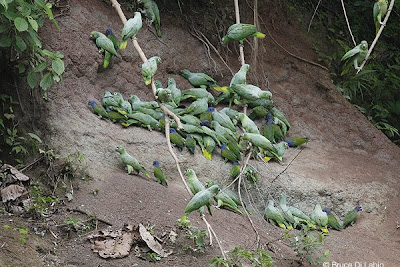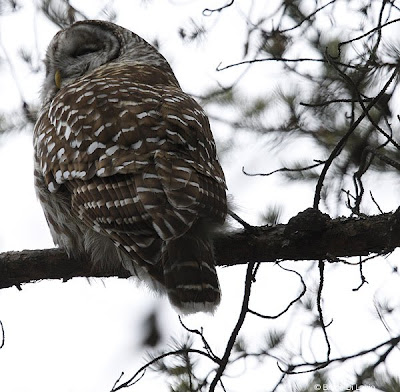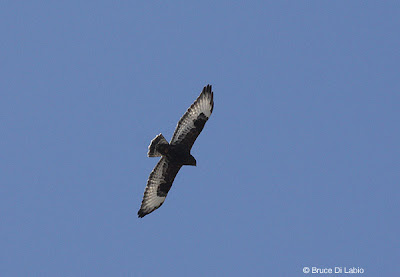
Thursday, January 28, 2010
January 28 to February 2, 2010 Birding Napo Wildlife Center, Ecuador
Birding the Napo Wildlife Center was amazing with lots of exciting birds and mammals. Highlights were many including the ZigZag Heron, Black-necked Red Cotinga and Golden-mantled Tamarin. Most days were spent either canoeing through the many waterways or walking trails. One morning was spent in the canopy tower looking for varies species of hawks, eagles, cotingas and more! The tower is approximatley 120 feet high with 209 steps to get to the top.


Wednesday, January 27, 2010
January 27, 2010 Ecuador Birding
Arrived in Ecuador late January 26th, my first visit to South America. The day started in Ottawa at 2:00am and I arrived in Quito at 10:30pm. My first day birding was amazing with around 20 lifers including Indigo Flowerpiecer, Orange-breasted Fruiteater, Blue-winged Moutain Tanager and a visit to an Oilbird nesting site. Tomorrow morning flying out to Coca than by boat along the Napo River to Napo Wildlife Center.
Monday, January 25, 2010
January 23 & 24, 2010 Birding Amherst and Wolfe Island
It was another great day both weather wise and owling today, January 23rd, on Amherst Island. After missing the Boreal Owl yesterday, it was out in the open in the Jack Pine Plantation and a lifer for many birders. At least 3 Northern Saw-whet Owl and 1 Barred Owl were present in the "Owl Woods" and 2 Snowy Owls on the KFN property at the east end of the island. At dusk there were 10+ Short-eared Owls observed at dusk just east of Stella along with 1 Snowy Owl.
Good Birding, Bruce
Directions: Amherst Island: Located 18 km. west of Kingston. Exit off Hwy. 401 at exit 593 (County Rd. 4, Camden East) and drive south to the very end (Millhaven). Turn right on Hwy. 33 and drive 100 metres until you see the sign for the Amherst Island ferry. The ferry (20 minute trip) leaves the mainland on the half hour and leaves the island on the hour. Cost is $8.00 Canadian round trip. There are no gas stations on the island. There are restrooms on the ferry, and at the island ferry dock. The East End K.F.N. property is at the easternmost part of the island on the east side of the Lower Forty Foot Road.
Because of liability issues, visitors to the Kingston Field Naturalists' property at the east end of Amherst Island MUST be accompanied by a KFN
member. For KFN contact information or how to become a member, please visit
http://kingstonfieldnaturalists.org/ ."
On January 24th spent part of the day birding Wolfe Island. It was quite a contrast to Amherst Island with only a few Red-tailed Hawks but 20+ Bald Eagles mainly along the south side and east end of the island. We did observe 1 Northern Shrike along Carpenters Pt. Road and over 200+ Tundra Swan and 6 Mute Swan. There was 1 American Coot and 3 adult Ring-billed Gull at the Kingston dock. The DuPont Plant lagoon/Elevator Bay had a good variety of ducks including 1 Ruddy Duck, 1 American Wigeon, 9 Ring-necked Duck, both Greater and Lesser Scaup, 7 Hooded Merganser, 2 Gadwall, and 24 American Coot.
Good Birding, Bruce
Wolfe Island Ferry: The Wolfe Island ferry terminal is located in downtown Kingston at the foot of Barrack Street, about 2 blocks east of City Hall. From here the ferry leaves for Wolfe Island about every hour (See schedule) and it is a 20 minute ride to Wolfe Island.
Directions: DuPont Plant: From Hwy. 401 take exit 615 (Sir John A.MacDonald) and proceed south to King St. West and turn right (west). Proceed west past Portsmouth Ave. to Cataraqui (Elevator) Bay where King St. becomes Front Rd. and where the DuPont (Invista) Plant property begins. The DuPont Pond is located by turning left (south) at the traffic lights and left again onto the road through the fence.
Good Birding, Bruce
Directions: Amherst Island: Located 18 km. west of Kingston. Exit off Hwy. 401 at exit 593 (County Rd. 4, Camden East) and drive south to the very end (Millhaven). Turn right on Hwy. 33 and drive 100 metres until you see the sign for the Amherst Island ferry. The ferry (20 minute trip) leaves the mainland on the half hour and leaves the island on the hour. Cost is $8.00 Canadian round trip. There are no gas stations on the island. There are restrooms on the ferry, and at the island ferry dock. The East End K.F.N. property is at the easternmost part of the island on the east side of the Lower Forty Foot Road.
Because of liability issues, visitors to the Kingston Field Naturalists' property at the east end of Amherst Island MUST be accompanied by a KFN
member. For KFN contact information or how to become a member, please visit
http://kingstonfieldnaturalists.org/ ."
On January 24th spent part of the day birding Wolfe Island. It was quite a contrast to Amherst Island with only a few Red-tailed Hawks but 20+ Bald Eagles mainly along the south side and east end of the island. We did observe 1 Northern Shrike along Carpenters Pt. Road and over 200+ Tundra Swan and 6 Mute Swan. There was 1 American Coot and 3 adult Ring-billed Gull at the Kingston dock. The DuPont Plant lagoon/Elevator Bay had a good variety of ducks including 1 Ruddy Duck, 1 American Wigeon, 9 Ring-necked Duck, both Greater and Lesser Scaup, 7 Hooded Merganser, 2 Gadwall, and 24 American Coot.
Good Birding, Bruce
Wolfe Island Ferry: The Wolfe Island ferry terminal is located in downtown Kingston at the foot of Barrack Street, about 2 blocks east of City Hall. From here the ferry leaves for Wolfe Island about every hour (See schedule) and it is a 20 minute ride to Wolfe Island.
Directions: DuPont Plant: From Hwy. 401 take exit 615 (Sir John A.MacDonald) and proceed south to King St. West and turn right (west). Proceed west past Portsmouth Ave. to Cataraqui (Elevator) Bay where King St. becomes Front Rd. and where the DuPont (Invista) Plant property begins. The DuPont Pond is located by turning left (south) at the traffic lights and left again onto the road through the fence.
Friday, January 22, 2010
January 22,2010 Amherst Island birding
Spent another day birding Amherst Island. The weather was great, nice and sunny with a light breeze off the lake. We managed to find 3 Northern Saw-whet Owls and 1 Barred Owl in the "Owl Woods" but unfortunately, no Boreal Owl. I'm sure its still there but hiding well. No Long-eared Owls were found in the woods, but 3 Snowy Owls were seen on the KFN property at the east end. A small number of hawks including Red-tailed and Rough-legged, Northern Harrier and a couple of American Kestrel were seen on the island during the tour.
Good Birding, Bruce
Directions: Amherst Island: Located 18 km. west of Kingston. Exit off Hwy. 401 at exit 593 (County Rd. 4, Camden East) and drive south to the very end (Millhaven). Turn right on Hwy. 33 and drive 100 metres until you see the sign for the Amherst Island ferry. The ferry (20 minute trip) leaves the mainland on the half hour and leaves the island on the hour. Cost is $8.00 Canadian round trip. There are no gas stations on the island. There are restrooms on the ferry, and at the island ferry dock. The East End K.F.N. property is at the easternmost part of the island on the east side of the Lower Forty Foot Road.
Because of liability issues, visitors to the Kingston Field Naturalists' property at the east end of Amherst Island MUST be accompanied by a KFN
member. For KFN contact information or how to become a member, please visit
http://kingstonfieldnaturalists.org/ ."



Good Birding, Bruce
Directions: Amherst Island: Located 18 km. west of Kingston. Exit off Hwy. 401 at exit 593 (County Rd. 4, Camden East) and drive south to the very end (Millhaven). Turn right on Hwy. 33 and drive 100 metres until you see the sign for the Amherst Island ferry. The ferry (20 minute trip) leaves the mainland on the half hour and leaves the island on the hour. Cost is $8.00 Canadian round trip. There are no gas stations on the island. There are restrooms on the ferry, and at the island ferry dock. The East End K.F.N. property is at the easternmost part of the island on the east side of the Lower Forty Foot Road.
Because of liability issues, visitors to the Kingston Field Naturalists' property at the east end of Amherst Island MUST be accompanied by a KFN
member. For KFN contact information or how to become a member, please visit
http://kingstonfieldnaturalists.org/ ."

A series of Northern Saw-whet Owl photographs.


Thursday, January 21, 2010
January 21, 2010 Amherst Island Birding
The birding on Amherst Island was very good today with a nice selection of owls and hawks. In the "Owl Woods" we found 1 Boreal, 3 Northern Saw-whet, 1 Barred, and 1 Long-eared Owl. At the East End (KFN property) there were 2 Snowy Owls and near Stella 1 Short-eared Owl was observed sitting on a fence post. The hawks included 22 Red-tailed and 9 Rough-legged Hawk, 6 Northern Harrier and 2 American Kestrel. There is little snow cover on the island and the road into the "Owl Woods" is open but has limited parking. Also, the trail in the woods is icy in some areas. Good Birding, Bruce
Directions: Amherst Island: Located 18 km. west of Kingston. Exit off Hwy. 401 at exit 593 (County Rd. 4, Camden East) and drive south to the very end (Millhaven). Turn right on Hwy. 33 and drive 100 metres until you see the sign for the Amherst Island ferry. The ferry (20 minute trip) leaves the mainland on the half hour and leaves the island on the hour. Cost is $8.00 Canadian round trip. There are no gas stations on the island. There are restrooms on the ferry, and at the island ferry dock. The East End K.F.N. property is at the easternmost part of the island on the east side of the Lower Forty Foot Road. Because of liability issues, visitors to the Kingston Field Naturalists' property at the east end of Amherst Island MUST be accompanied by a KFN member. For KFN contact information or how to become a member, please visit http://kingstonfieldnaturalists.org/ ."

With the lack of heavy snow cover, Snowy Owls are easier to pick out at the east end on the KFN property.
Directions: Amherst Island: Located 18 km. west of Kingston. Exit off Hwy. 401 at exit 593 (County Rd. 4, Camden East) and drive south to the very end (Millhaven). Turn right on Hwy. 33 and drive 100 metres until you see the sign for the Amherst Island ferry. The ferry (20 minute trip) leaves the mainland on the half hour and leaves the island on the hour. Cost is $8.00 Canadian round trip. There are no gas stations on the island. There are restrooms on the ferry, and at the island ferry dock. The East End K.F.N. property is at the easternmost part of the island on the east side of the Lower Forty Foot Road. Because of liability issues, visitors to the Kingston Field Naturalists' property at the east end of Amherst Island MUST be accompanied by a KFN member. For KFN contact information or how to become a member, please visit http://kingstonfieldnaturalists.org/ ."

With the lack of heavy snow cover, Snowy Owls are easier to pick out at the east end on the KFN property.
Tuesday, January 19, 2010
January 19, 2010 Snowy Owls, Barrow's Goldeneye and Song Sparrows east of Ottawa.
Spent the morning birding various sites around the Ottawa area. Along Eagleson Road near Brownlee road we observed a flock of 300+ Snow Bunting and 1 Red-tailed Hawk at Hwy. 416 and Bankfield Road. The most interesting area near Ste. Rose just east of Casselman. We observed 4 Snowy Owls, 1 Cooper's, Rough-legged, and 1 Red-tailed Hawk. There was also a large flock of Snow Buntings. The biggest surprise was 4 Song Sparrows , a flock of three and a single birds feeding along the shoulder of the road where the grass was exposed. Along the Rideau River at the Rideau Tennis Club 1 male Barrow's Goldeneye was still present feeding in the remaining small area of open water along with 20+ Common Goldeneye and 200+ Mallards and a few Am. Black Ducks.
Thursday, January 14, 2010
January 13, 14, & 15, 2010 Redwing and more birding in Newfoundland.
Birding on January 13th was again great, the highlight being a REDWING, a European thrush that occasionally reaches Newfoundland during the late fall and winter. It breeds close-by in Greenland and Iceland. The Redwing was spotted by my good friend and fellow birder, Bruce Mactavish, who lives in St. John's. The Redwing was in a flock of 75+ American Robins feeding on Mountain Ash or Dog Berry. Bruce and I have quite a history. We both grew up in Ottawa in the late 60's/early 70's and were part of the legendary "Bike Gang". The "gang" was a group of 8-10 teenage birders who used the only means of transportation available to them, their bikes, to bird the entire Ottawa region. In the early birding days, Bruce was well known for his amazing skills in finding rarities and on this trip, he continued his legacy. The Redwing made a few brief appearances before flying off with the flock of American Robins. The Redwing was located the following 2 days by local birding guide, Dave Brown, and photographed.
Bruce also taught me a new birding technique, called "ditch birding". In winter, ditch birding is regularly checking open creeks, streams and wet areas for rarities. We spent a couple of afternoons "ditch birding", hoping to find an Eurasian Woodcock, Common Snipe or Jack Snipe. We did find 5 Wilson's Snipe.
We also visited a number of feeders on the Avalon Peninsula. Small numbers of Song and White-throated Sparrows and a small flock of Common Grackles were observed. Other birds of note for the day included 4 Horned Grebe, 3 Red-throated Loon, 1 Rough-legged Hawk and a Common Murre. Unfortunately Dovekie's which are usually easy to see, were not cooperating on our tour of the Avalon. The next day we birded in the St. John's area and had great views of a number of Lesser Black-backed Gulls. On January 15th we birded the South Shore Road area of the Avalon and had great views of a flock of Purple Sandpipers with a few Ruddy Turnstone. The winds were strong 40+km and the seas were rough making observations on the water difficult. All in all a wonderful trip to Newfoundland!


Bruce also taught me a new birding technique, called "ditch birding". In winter, ditch birding is regularly checking open creeks, streams and wet areas for rarities. We spent a couple of afternoons "ditch birding", hoping to find an Eurasian Woodcock, Common Snipe or Jack Snipe. We did find 5 Wilson's Snipe.
We also visited a number of feeders on the Avalon Peninsula. Small numbers of Song and White-throated Sparrows and a small flock of Common Grackles were observed. Other birds of note for the day included 4 Horned Grebe, 3 Red-throated Loon, 1 Rough-legged Hawk and a Common Murre. Unfortunately Dovekie's which are usually easy to see, were not cooperating on our tour of the Avalon. The next day we birded in the St. John's area and had great views of a number of Lesser Black-backed Gulls. On January 15th we birded the South Shore Road area of the Avalon and had great views of a flock of Purple Sandpipers with a few Ruddy Turnstone. The winds were strong 40+km and the seas were rough making observations on the water difficult. All in all a wonderful trip to Newfoundland!

Both the Ruddy Turnstone and Purple Sandpiper were equally interested in the clams.

One of 5 Wilson's Snipe seen while " ditch birding".
Subscribe to:
Posts (Atom)

















































